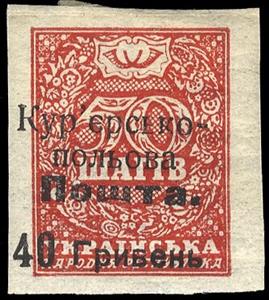Stamp: Inscription of value (Ukraine 1920)
Inscription of value (Ukraine 1920)
26 August (Ukraine ) within release Courier Field Post issue goes into circulation Stamp Inscription of value face value 40 Ukrainian hryvnia
| Stamp Inscription of value in catalogues | |
|---|---|
| Stamp Number: | Sn: UA M15 |
Stamp is vertical format.
50 shahiv stamp of 1918 surcharged "Кур'єрсько- польова Пошта. 40 Гривень" in black Issued for use on registered mail between the Ukrainian government-in-exile at Tarnów, Poland and its military units in Ukraine during the Ukrainian-Soviet War.Also in the issue Courier Field Post issue:
- Stamp - Allegorical Ukraine face value 10;
- Stamp - Allegorical Ukraine face value 20;
- Stamp - Allegorical Ukraine face value 40;
- Stamp - Inscription of value face value 10;
- Stamp - Inscription of value face value 20;
- Stamp - Inscription of value face value 40;
- Stamp - Trident emblem (tryzub) face value 10;
- Stamp - Trident emblem (tryzub) face value 10;
- Stamp - Trident emblem (tryzub) face value 20;
- Stamp - Trident emblem (tryzub) face value 20;
- Stamp - Trident emblem (tryzub) face value 40;
- Stamp - Trident emblem (tryzub) face value 40;
- Stamp - Trident emblem (tryzub) and text face value 40;
- Stamp - Ukrainian peasant face value 10;
- Stamp - Ukrainian peasant face value 20;
- Stamp - Ukrainian peasant face value 40;
Stamp Inscription of value it reflects the thematic directions:
A musical instrument is a device created or adapted to make musical sounds. In principle, any object that produces sound can be considered a musical instrument—it is through purpose that the object becomes a musical instrument. A person who plays a musical instrument is known as an instrumentalist. The history of musical instruments dates to the beginnings of human culture. Early musical instruments may have been used for rituals, such as a horn to signal success on the hunt, or a drum in a religious ceremony. Cultures eventually developed composition and performance of melodies for entertainment. Musical instruments evolved in step with changing applications and technologies.
A number is a mathematical object used to count, measure, and label. The most basic examples are the natural numbers 1, 2, 3, 4, and so forth. Numbers can be represented in language with number words. More universally, individual numbers can be represented by symbols, called numerals; for example, "5" is a numeral that represents the number five. As only a relatively small number of symbols can be memorized, basic numerals are commonly organized in a numeral system, which is an organized way to represent any number. The most common numeral system is the Hindu–Arabic numeral system, which allows for the representation of any non-negative integer using a combination of ten fundamental numeric symbols, called digits. In addition to their use in counting and measuring, numerals are often used for labels (as with telephone numbers), for ordering (as with serial numbers), and for codes (as with ISBNs). In common usage, a numeral is not clearly distinguished from the number that it represents.

